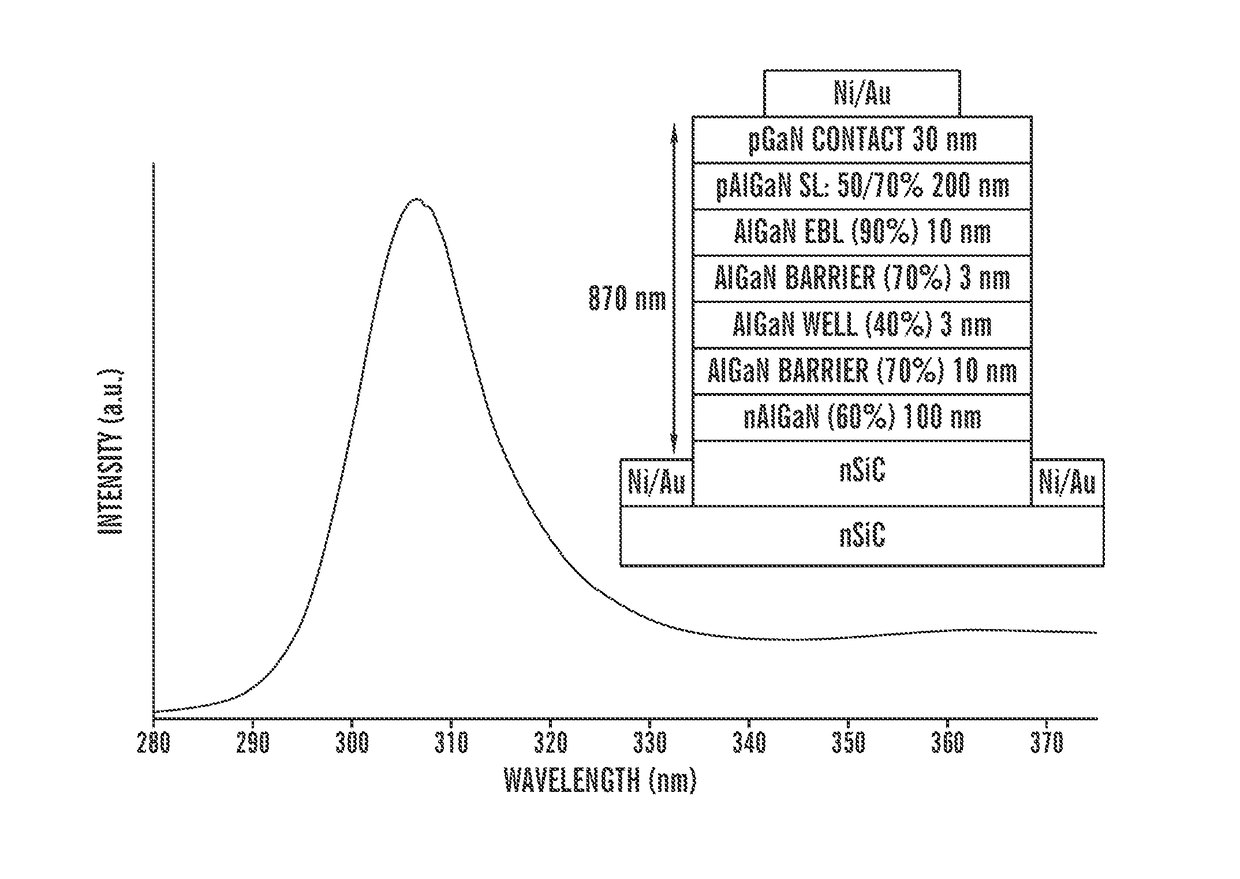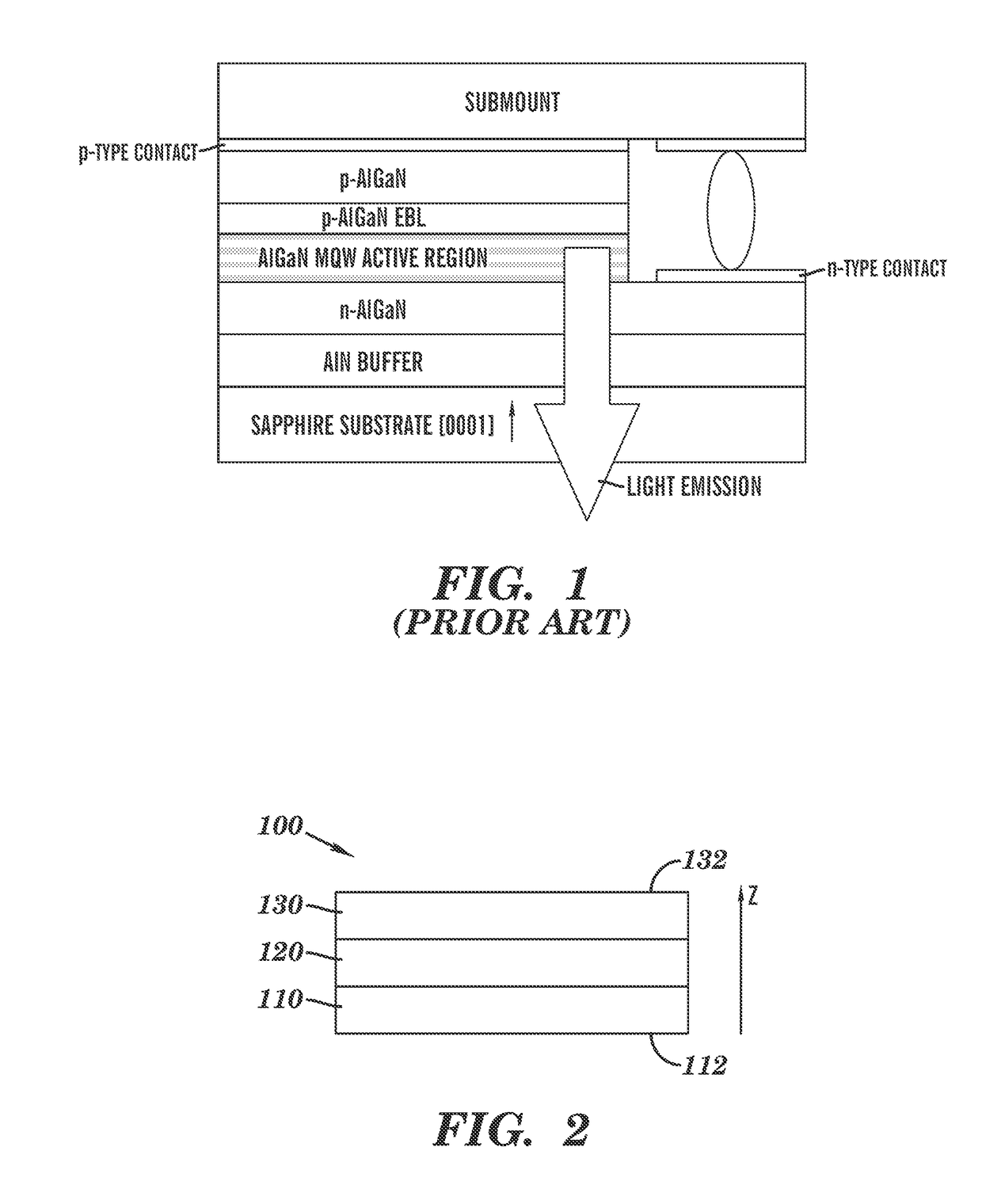Ultraviolet light emitting diodes
a light-emitting diode and ultra-violet technology, applied in the direction of basic electric elements, electrical apparatus, semiconductor devices, etc., can solve the problems of low iqe, poor eqe of deep ultra-violet leds, and high concentration of threading defects, so as to increase the extraction of light out of the device, reduce the absorption loss of the substrate, and increase the ee
- Summary
- Abstract
- Description
- Claims
- Application Information
AI Technical Summary
Benefits of technology
Problems solved by technology
Method used
Image
Examples
example 1
[0147]As a non-limiting example, an LED as described above can be grown on a p-SiC substrate as shown schematically in FIGS. 15A-15B. For said example, a Veeco GEN-II plasma assisted MBE system was used to grow the full device. The substrate was cleaned in situ by sequential cycles of Ga accumulation and evaporation. An undoped 40 nm thick AlN electron-blocking layer was grown using In as a surfactant. The active region consisted of 15 quantum wells 2 nm thick of 40% AlN mole fraction AlGaN alloy. Barriers for the wells consisted of 2 nm of 60% AlN mole fraction AlGaN alloy. The growth of the active region commenced with a barrier being grown against the electron blocking layer and terminated with a final barrier (bringing the active region to a total of 15.5 bilayers). The device growth was completed with 600 nm of 55% AlN mole fraction n-AlGaN.
[0148]In said example, mesas are used to define individual devices. Mesas can be defined by, for example, chlorine based reactive ion etchi...
example 2
[0154]As a non-limiting example, a UV LED including a p-doped AlGaN film between p-SiC and p-AlN blocking layer is shown schematically in FIGS. 17A-17B. First, a 900 nm p-GaN film was grown on the p-SiC substrate. The electron-blocking layer consisted of 40 nm of AlN doped with Mg. The active region consisted of 2 AlGaN quantum wells 3 nm thick and an AlN mole fraction of 40%. As shown in FIG. 17B mesa structure was formed by chlorine-based etching followed by contacting the n-AlGaN with Ti / Al contacts and contacting the p-SiC with Al / Ti contacts. The rectifying behavior of said example device is clearly illustrated by the IV characteristic shown in FIG. 17C. The UV electroluminescence spectrum of said example device is shown in FIG. 17D. The band structure of said example device is expected to follow that of the calculated band structure of a slightly different device shown in FIG. 16B.
example 3
[0155]Superlattice DBRs and repeated graded layer DBRs have been grown as schematically shown in FIG. 18. The reflectance properties were measured using a CARY 5000 UV / Vis / NIR spectrophotometer at near-normal incidence (8 degrees), and referenced to a deep UV (DUV) enhanced A1 mirror baseline which we assumed was 80% reflective in the DUV. The superlattice DBR was composed of bilayers SL-A and SL-B, where SL-A is (Al0.70Ga0.30N / Al0.90Ga0.10N-0.8 / 0.8 nm) and SL-B is (Al0.70 Ga0.30N / Al0.50Ga0.50N-0.8 / 0.8 nm). Each SL contained 17 bilayers, giving each DBR bilayer a nominal thickness 54 nm. The experimental and the predicted (by the transfer matrix method) reflectance spectra of the superlattice DBR is shown in FIG. 19A with a peak reflectance of 42%. DBRs with sinusoidal, triangular, and sawtooth graded AlGaN composition profiles were grown along with a square (traditional DBR) compositional profile. Each DBR had a minimum AlN mole fraction of 50% and a maximum AlN mole fraction of 85...
PUM
 Login to View More
Login to View More Abstract
Description
Claims
Application Information
 Login to View More
Login to View More - R&D
- Intellectual Property
- Life Sciences
- Materials
- Tech Scout
- Unparalleled Data Quality
- Higher Quality Content
- 60% Fewer Hallucinations
Browse by: Latest US Patents, China's latest patents, Technical Efficacy Thesaurus, Application Domain, Technology Topic, Popular Technical Reports.
© 2025 PatSnap. All rights reserved.Legal|Privacy policy|Modern Slavery Act Transparency Statement|Sitemap|About US| Contact US: help@patsnap.com



